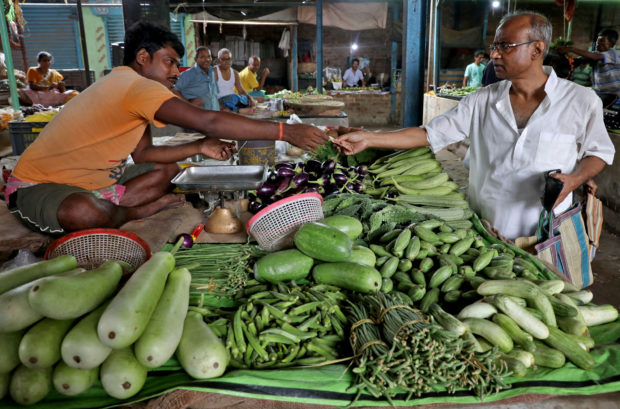
Nikhil Kumar Mondal, 65, a retired school headmaster, buys vegetables from a vendor at a market on the outskirts of Kolkata, India, May 20, 2022. REUTERS/Rupak De Chowdhuri/File photo
BENGALURU – The Reserve Bank of India will increase its main interest rate by 25 basis points to 6.75 percent in April and then pause until the end of 2023, according to a Reuters poll of economists who also said risks were for the terminal rate to go even higher.
Following higher-than-expected January inflation and after the central bank reiterated its tightening bias at its Feb. 8 meeting, economists lifted their forecast for the terminal rate from 6.5 percent expected in a January poll.
Nearly two-thirds of respondents, 34 of 55, expected the Reserve Bank of India (RBI) to raise rates to a seven-year high of 6.75 percent in April and the median forecast in the Feb. 14-21 Reuters poll showed it would then keep the rate steady for the rest of 2023. Since last May, India’s central bank has raised rates by 250 basis points.
“The RBI… very clearly indicated that they’re still in the mode of withdrawing the accommodation. They need to see a decisive fall in inflation happen for them to change their stance to neutral,” said Dhiraj Nim, economist at ANZ Research.
“The volatility in food prices is a bit of a concern right now, and we have to see what happens on that front for the overall inflation trajectory to be shaped. Core inflation… is problematically sticky at 6 percent. If it does not come below that, I think the job of the Reserve Bank of India is not done.”
Inflation in Asia’s third-largest economy was above the central bank’s upper tolerance limit of 6 percent for the first 10 months of 2022, followed by two months of decline on softening food prices.
However, in January, food inflation accelerated once again, taking the headline number to 6.52 percent, well above the central bank’s upper tolerance limit.
The survey also showed inflation was likely to remain sticky at 6 percent this quarter, higher than the RBI’s forecast of 5.7 percent.
All 27 respondents who answered additional questions said the biggest risk to their inflation and terminal rate forecasts was that these rates would be higher than they predicted.
Globally, persistent inflation is prompting major central banks to continue tightening monetary policy until price pressures are tamed.
The RBI, however, is likely to end its tightening cycle in April, as growth in the Indian economy was predicted to slow to 6 percent in 2023/24 from 6.9 percent in the current fiscal year, the poll showed.
Over a third of survey respondents, however, said the RBI was already done with its policy tightening campaign, and the terminal rate would stay at 6.5 percent as the bank weighs the effects of earlier hikes.
“Much water needs to flow under the bridge between now and April, including a GDP print and February CPI print, so we are not making any changes (to our forecast) for now,” noted Sajjid Chinoy, chief India economist at J.P. Morgan.

